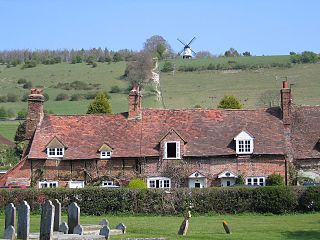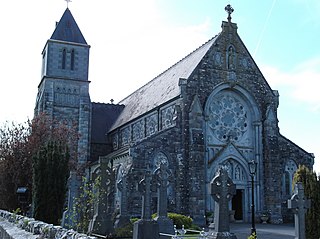Related Research Articles
The Lord High Chancellor of Ireland was the highest judicial office in Ireland until the establishment of the Irish Free State in 1922. From 1721 to 1801, it was also the highest political office of the Irish Parliament: the Chancellor was Speaker of the Irish House of Lords. The Lord Chancellor was also Lord Keeper of the Great Seal of Ireland. In all three respects, the office mirrored the Lord High Chancellor of Great Britain.

Walter de Lacy was lord of Meath in Ireland. He was also a substantial land owner in Weobley, Herefordshire, in Ludlow, Shropshire, in Ewyas Lacy in the Welsh Marches, and several lands in Normandy. He was the eldest son of Hugh de Lacy, a leading Cambro-Norman baron in the Norman invasion of Ireland, and Rohese of Monmouth.

Ralph de Monthermer, 1st Baron Monthermer, Earl of Gloucester, Hertford, and Atholl was an English nobleman, who was the son-in-law of King Edward I. His clandestine marriage to the King's widowed daughter Joan greatly offended her father, but he was quickly persuaded to pardon Ralph.
Sir William Bereford was an English justice.
Thomas de Clare, Lord of Thomond was an Anglo-Norman peer and soldier. He was the second son of Richard de Clare, 6th Earl of Gloucester and his wife Maud de Lacy, Countess of Gloucester. In 1272 he served a term as Lieutenant of the Duchy of Aquitaine. On 26 January 1276 he was granted the Lordship of Thomond by Edward I of England; he spent the next eight years attempting to conquer it from the O'Brien dynasty, kings of Thomond.

Geoffrey de Turville or de Tourville was an English-born judge and cleric in thirteenth-century Ireland, who held office as Bishop of Ossory and Lord Chancellor of Ireland, and was noted as an extremely efficient administrator. His career has been described as an excellent example of what a clerk in the royal service in that era might hope to accomplish.

Alexander de Balscot, also known as Alexander Petit was one of the leading Irish clerics and statesmen of the late fourteenth century, who held the offices of Bishop of Ossory, Bishop of Meath, Treasurer of Ireland and Lord Chancellor of Ireland.

Thomas Cantock, Quantock or Cantok was an English-born cleric and judge in medieval Ireland, who held the offices of Bishop of Emly and Lord Chancellor of Ireland.
Walter de Thornbury was an English-born statesman and cleric in 14th century Ireland who held the office of Lord Chancellor of Ireland. His efforts to secure confirmation of his election as Archbishop of Dublin were ended in tragedy with his death in a shipwreck.
Walter de Islip, Isleep or de Istlep was an English-born cleric, statesman, and judge in fourteenth-century Ireland. He was the first Chief Baron of the Irish Exchequer; he also held the offices of Treasurer of Ireland, Chief Escheator, and Custos Rotulorum of Kilkenny. He was a noted pluralist, who held numerous benefices. His career was seriously damaged by accusations of corruption and maladministration. He played an important role in the celebrated Kilkenny Witchcraft Trials of 1324.
Nicholas de Balscote was an English-born official and judge in fourteenth-century Ireland. He attained high judicial office, but his career was damaged by a quarrel with King Edward II.
The Lordship of Meath was an extensive seigneurial liberty in medieval Ireland that was awarded to Hugh de Lacy by King Henry II of England by the service of fifty knights and with almost royal authority. The Lordship was roughly co-extensive with the medieval kingdom of Meath. At its greatest extent, it included all of the modern counties of Fingal, Meath, Westmeath as well as parts of counties Cavan, Kildare, Longford, Louth and Offaly. The Lordship or fiefdom was imbued with privileges enjoyed in no other Irish liberty, including the four royal pleas of arson, forestalling, rape, and treasure trove.
John de Grauntsete or Grantsete (or John of Grantchester) (c. 1270 – c. 1350) was an English judge who lived in fourteenth-century Ireland. We know more about him than we do about any other contemporary Irish judge, and from the surviving information we can form some idea of the lifestyle of an Irish judge in his time. He sat in turn in each of the Irish Courts of common law, and uniquely he is known to have appeared in Court as an advocate even after he became a judge.
Geoffrey de Morton was a wealthy merchant and shipowner in early fourteenth-century Dublin who served as Mayor of Dublin in 1303.
Walter de Cusack was an Anglo-Irish judge, magnate and military commander of the fourteenth century.
Hugh Canoun, or Hugh Canon was an English-born judge in early fourteenth-century Ireland. He was a justice of the Court of Common Pleas (Ireland) and served as Deputy Justiciar of Ireland. As a judge he was praised for his good and faithful service to the English Crown, and as a lawyer he was known as "a man very knowledgeable about all the King's business". On the other hand, his loyalty to the Crown during the Scottish Invasion of Ireland in 1315-18 was said to be extremely doubtful, although he was saved from disgrace by his influential connections. He was murdered by Andrew de Bermingham of Athenry in 1317/18, during the last months of the Bruce Invasion, in the course of a private feud, of which little is known.
David le Blond was an Irish judge in the reign of King Edward II of England, who was notorious for corruption.

Waleran de Wellesley was a judge, statesman and landowner in thirteenth century Ireland. He was a member of the Privy Council of Ireland. He was the ancestor of the Duke of Wellington, and was the first of the de Wellesley family to settle in Ireland.
Sir Walter l'Enfant the younger, lord of Carnalway, County Kildare was an Irish judge and landowner.
Ralph de Norwich (c.1180–1259) was an English-born cleric, judge and Crown servant to King John and King Henry III, much of whose career was spent in Ireland, where he held office as Lord Chancellor of Ireland for several years. He was elected Archbishop of Dublin in 1256, but his election was vetoed by the Pope, on the grounds that despite his clerical office he was essentially a secular official, and too devoted to the King's interests to be a good servant of the Pope.